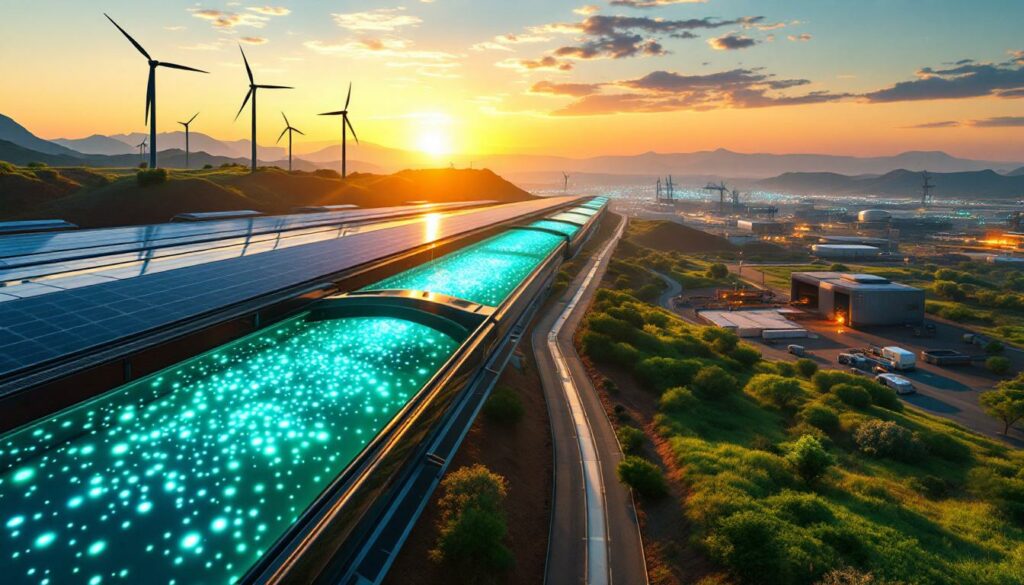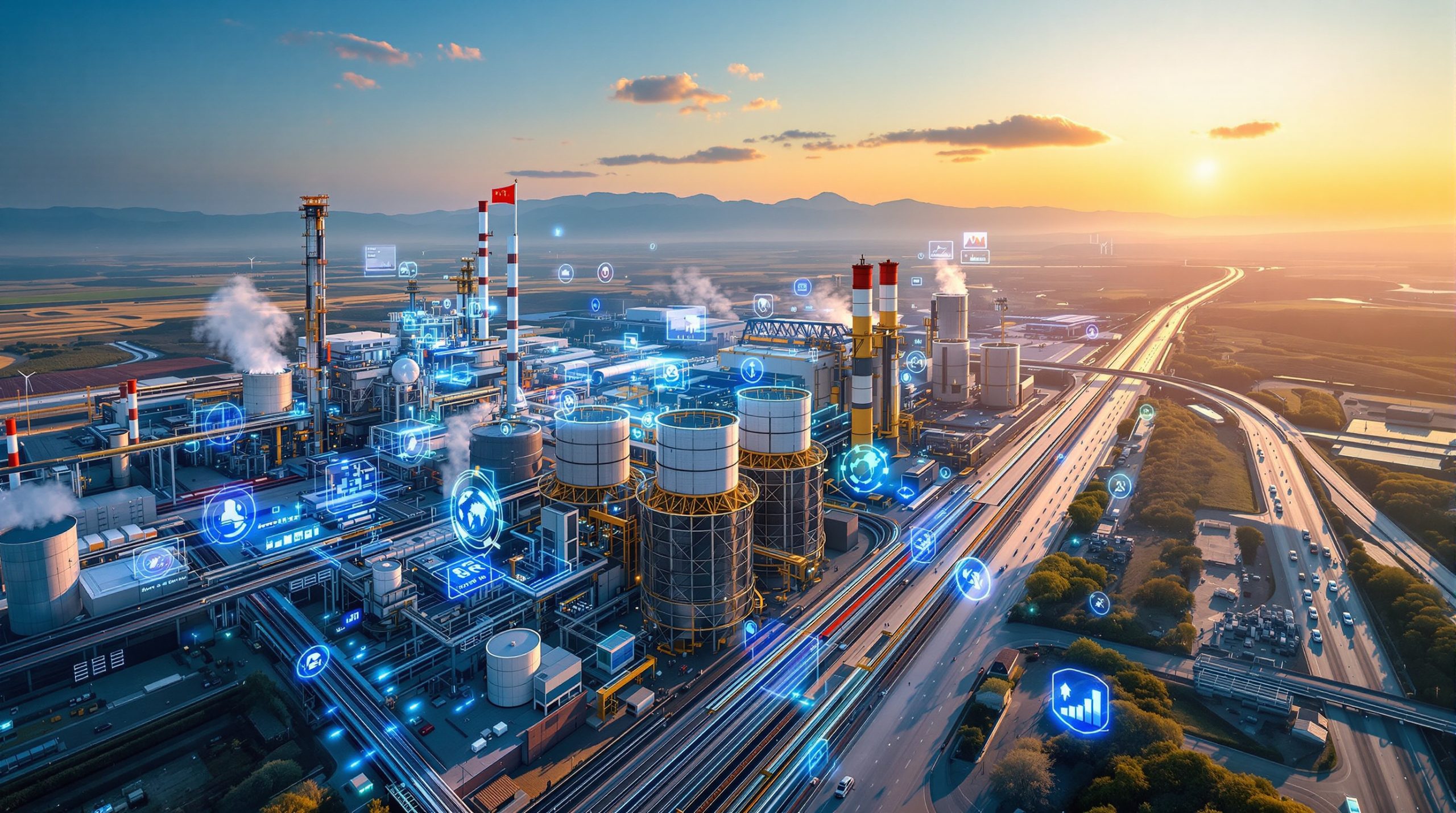What is Green Hydrogen and Why is it Important for South Africa?
Green hydrogen represents a revolutionary energy carrier produced through electrolysis powered by renewable energy sources. This process splits water into hydrogen and oxygen with zero carbon emissions – fundamentally different from gray or blue hydrogen, which rely on fossil fuels and produce significant carbon emissions even with carbon capture technology.
South Africa stands at a unique crossroads in the global green hydrogen landscape, possessing three critical advantages that position it as a potential leader in this emerging market.
Understanding Green Hydrogen Technology
Green hydrogen production requires renewable electricity to power electrolyzers, which split water molecules into hydrogen and oxygen. The resulting hydrogen can be used across multiple sectors: as fuel for transportation, feedstock for industrial processes, or converted back to electricity through fuel cells. Unlike fossil fuel-based energy carriers, green hydrogen produces only water vapor when utilized, making it a truly clean energy solution.
The technology's ability to store renewable energy for extended periods addresses the intermittency challenges of solar and wind power. When renewable generation exceeds demand, the surplus electricity can produce hydrogen, which can be stored and later used when renewable generation falls short.
South Africa's Strategic Advantages
South Africa possesses world-class renewable energy resources, particularly in the Northern Cape region, where solar irradiation levels exceed 2,800 kWh/m²/year – among the highest globally. Wind resources along the coastal regions are similarly exceptional, with capacity factors reaching 35-45%, well above global averages. These renewable endowments create ideal conditions for producing cost-competitive green hydrogen.
The country's geological gifts extend beyond renewable potential. South Africa holds approximately 80% of the world's platinum group metals (PGMs) reserves – critical materials used as catalysts in both hydrogen fuel cells and electrolyzers. This natural advantage creates opportunities to develop domestic manufacturing capabilities across the hydrogen value chain, potentially transforming South Africa from a raw material exporter to a technology provider.
"South Africa's positioning in the PGM value chain gives us a unique competitive advantage in the hydrogen economy that few countries can match," noted Hydrogen South Africa (HySA) Director Dr. Phillimon Modisha in a recent industry conference. "We're not just talking about mining platinum – we're developing the technology to transform these metals into high-value components for the global hydrogen industry."
Additionally, South Africa's existing infrastructure provides logistical advantages for hydrogen development. The country's deep-water ports, established industrial zones, and extensive gas transmission networks can be adapted to support hydrogen production and export. Saldanha Bay, Richards Bay, and Coega have already been identified as potential hydrogen export hubs, leveraging existing infrastructure to minimize development costs.
How is South Africa Positioning Itself in the Global Hydrogen Economy?
South Africa has recognized the strategic importance of green hydrogen as both an economic opportunity and a pathway to decarbonization. The government and private sector have taken concrete steps to establish the country as a significant player in the emerging global hydrogen market.
National Hydrogen Strategy and Policy Framework
South Africa's Hydrogen Society Roadmap, launched in 2021, outlines a comprehensive approach to developing a domestic hydrogen economy. The roadmap identifies key opportunity areas including platinum-based fuel cells, green hydrogen production, and synthetic fuels manufacturing. It establishes a phased implementation plan starting with pilot projects and scaling to commercial operations by 2030.
The policy framework is being strengthened through several initiatives:
- Integration of hydrogen into the Integrated Resource Plan (IRP) for electricity
- Development of specific hydrogen regulations within the Gas Act amendments
- Creation of Special Economic Zones (SEZs) focused on hydrogen and related industries
- Tax incentives for renewable hydrogen investments under Section 12L of the Income Tax Act
These policy measures align with South Africa's broader commitment to achieve net-zero emissions by 2050 while supporting the just energy transition strategies away from coal dependency. The National Business Initiative (NBI) has identified green hydrogen as one of the key pathways to decarbonize South Africa's carbon-intensive economy, particularly in hard-to-abate sectors like steel production, mining, and heavy transport.
International Partnerships and Funding Commitments
South Africa has secured significant international support for its hydrogen ambitions. The momentum in South Africa's hydrogen sector is accelerating, with major funding announcements demonstrating growing confidence in the country's green hydrogen potential.
In June 2023, Hive Hydrogen South Africa secured R146 billion ($8.1 billion) in backing from Standard Bank and RMB for its massive Nelson Mandela Bay green ammonia project. This represents one of the largest investment opportunities in Africa's renewable energy sector to date and signals serious commercial interest in South Africa's hydrogen potential.
Beyond financial investment, South Africa has established strategic partnerships with hydrogen-leading nations:
- Germany has committed €700 million through its H2Global initiative to support South African green hydrogen projects, particularly those targeting exports to Europe
- Japan's New Energy and Industrial Technology Development Organization (NEDO) is collaborating on fuel cell technology development leveraging South African PGMs
- The Netherlands has established a hydrogen import corridor focused on Rotterdam port, with South Africa identified as a key supplier
These partnerships extend beyond financing to include technology transfer, skills development, and market access agreements. They reflect a growing recognition of South Africa's potential role in addressing energy security concerns in regions lacking sufficient renewable resources to meet their decarbonization targets.
What Major Green Hydrogen Projects are Underway in South Africa?
South Africa's green hydrogen landscape is rapidly evolving from concept to concrete projects. Several flagship initiatives are now moving from feasibility studies to implementation, showcasing the country's commitment to becoming a significant player in the global hydrogen economy.
Boegoebaai Green Hydrogen Hub
Located in the Northern Cape province near the Namibian border, Boegoebaai represents South Africa's most ambitious green hydrogen project. Led by Sasol in partnership with the Industrial Development Corporation (IDC), this integrated development aims to leverage the region's exceptional solar and wind resources to produce green hydrogen and derivatives at scale.
The project's key components include:
- 5-10 GW of dedicated renewable energy capacity (solar PV and wind)
- Large-scale electrolysis facilities with multi-gigawatt capacity
- Ammonia synthesis plants for hydrogen conversion and transport
- A new deep-water port facility for export to international markets
- Pipeline connections to domestic industrial users
Estimated investment for the full development exceeds $10 billion, with implementation planned in phases. Initial production is targeted for 2028, with full capacity expected by 2035. The project's developers project production costs of $1.60-$2.10/kg by 2030, positioning it competitively in international markets.
What makes Boegoebaai particularly significant is its integrated approach to development. Rather than focusing solely on hydrogen production, the project incorporates the entire value chain from renewable energy generation to export facilities. This comprehensive approach aims to maximize economic benefits within South Africa rather than simply exporting raw resources.
Solar-Powered Hydrogen Clusters
While Boegoebaai represents a massive centralized approach, South Africa is also developing distributed hydrogen production clusters aligned with existing renewable energy development zones. These projects demonstrate how South Africa is capitalizing on its abundant solar resources to drive the hydrogen transition.
A notable example is the recently announced 1,430 MW solar cluster being developed by ACWA Power. This fully-permitted project will dedicate a significant portion of its capacity to green hydrogen production, with the remainder feeding into the national grid. The cluster's strategic location in the Northern Cape provides both optimal solar conditions and proximity to mining operations that can utilize the hydrogen output.
Other significant projects include:
- Prieska Power Reserve: A 900 MW integrated solar-wind-hydrogen facility in development by Central Energy Corporation
- Coega Hydrogen Valley: A hub of hydrogen applications including mobility, industrial use, and power generation
- Sasol's Secunda Hydrogen Integration: Transitioning the world's largest coal-to-liquids facility to use green hydrogen
These projects represent over $15 billion in planned investment and could collectively produce more than 500,000 tons of green hydrogen annually by 2030. This would position South Africa among the top five global hydrogen producers and establish the country as Africa's undisputed hydrogen leader.
How Will Green Hydrogen Transform South Africa's Mining and Industrial Sectors?
South Africa's economy has historically been built around mining and mineral processing – sectors that face increasing pressure to decarbonize. Green hydrogen presents a unique opportunity to transform these carbon-intensive industries while creating new value chains.
Decarbonizing Mining Operations
The mining sector, contributing approximately 8% to South Africa's GDP, stands to benefit significantly from green hydrogen adoption. Mining companies face growing pressure from investors and customers to reduce carbon footprints, with scope 1 and 2 emissions increasingly affecting access to capital and markets.
Green hydrogen offers multiple decarbonization pathways for mining operations:
-
Heavy machinery conversion: Replacing diesel-powered mining trucks with hydrogen fuel cell vehicles. Anglo American has already deployed the world's largest hydrogen mining truck at its Mogalakwena platinum mine, demonstrating the technology's viability.
-
Processing operations: Using hydrogen for high-temperature processes in mineral refining, replacing coal or natural gas. This is particularly relevant for energy-intensive processes like ferrochrome production.
-
Stationary power generation: Implementing hydrogen fuel cells for reliable off-grid power generation at remote mining sites, reducing dependency on diesel generators.
-
Green premium products: Producing low-carbon metals and minerals that command premium prices in international markets increasingly focused on supply chain emissions.
The Minerals Council South Africa estimates that implementing hydrogen technologies across the mining sector could reduce the industry's carbon emissions by 80% by 2040 while saving approximately R40 billion ($2.2 billion) in potential carbon taxes.
Revitalizing Ferroalloy Production
South Africa's ferroalloy industry, once a global powerhouse, has seen numerous smelters idled in recent years due to electricity constraints and rising costs. Green hydrogen presents an opportunity to revitalize this strategic sector through innovative production methods.
Research by Mintek, South Africa's national mineral research organization, has demonstrated world-leading applications of zero-emission hydrogen and aluminum as reductants in manganese ferroalloy production. This innovative process not only eliminates carbon emissions but also improves product quality and recovery rates.
"Our research shows that hydrogen-based reduction of manganese ores can achieve metallization rates exceeding 95% while eliminating carbon emissions entirely," explains Dr. Deshenthree Chetty, General Manager at Mintek. "This breakthrough could help South Africa reclaim its position in high-value ferromanganese markets while meeting stringent emissions requirements."
This innovation holds particular importance given South Africa's 74% share of global high-quality manganese ore resources. By pioneering hydrogen-based production methods, South Africa could move up the value chain from ore exports to high-value ferroalloy production, creating significant economic value while reducing environmental impact.
Industry analysts estimate that applying hydrogen technologies to South Africa's ferroalloy sector could generate additional annual export revenue of R15-20 billion ($830 million-$1.1 billion) by 2035 while creating 5,000-7,000 skilled jobs.
What Economic Benefits Can Green Hydrogen Bring to South Africa?
The green hydrogen economy represents a transformative economic opportunity for South Africa, potentially addressing several of the country's most pressing challenges: unemployment, economic diversification, and sustainable development.
Job Creation and Skills Development
According to analysis by the Council for Scientific and Industrial Research (CSIR), South Africa's hydrogen economy could create between 14,000 and 30,000 direct jobs by 2030, expanding to 50,000-70,000 by 2040 as the sector reaches full maturity. These employment opportunities span the entire value chain:
- Renewable energy development: Construction and operation of dedicated solar and wind facilities
- Manufacturing: Production of electrolyzers, fuel cells, and specialized components leveraging South Africa's existing industrial capabilities
- Operations: Technical roles in hydrogen production, compression, and distribution facilities
- Export infrastructure: Port operations, shipping, and logistics for international markets
- Applications: Implementation and maintenance of hydrogen technologies across various sectors
What makes the hydrogen economy particularly valuable from an employment perspective is the diverse skill levels required. While some positions demand advanced technical expertise, many roles are accessible to workers transitioning from other sectors, particularly those currently employed in fossil fuel industries.
Strategic skills development programs are being implemented to ensure South Africans can access these new jobs. The Department of Science and Innovation has established specialized hydrogen training programs at several universities, while Technical and Vocational Education and Training (TVET) colleges are developing practical courses focused on hydrogen technologies.
Export Opportunities and Revenue Generation
South Africa's exceptional renewable resources and strategic location position it ideally to become a major exporter of green hydrogen and its derivatives. This export potential could generate substantial revenue, helping to offset declining coal exports as global energy systems decarbonize.
Analysis by Hydrogen South Africa (HySA) suggests that by 2035, hydrogen exports could generate $3.5-$6 billion in annual revenue, potentially rising to $10-$12 billion by 2050 as markets mature and production scales. The most promising export products include:
- Ammonia: Used for fertilizer production and as a hydrogen carrier
- Synthetic fuels: Including green methanol and sustainable aviation fuel
- Direct hydrogen: Compressed or liquefied for specialized applications
- Green iron: Directly reduced iron using hydrogen instead of coal
The European Union, Japan, and South Korea have been identified as primary target markets based on their limited domestic renewable resources, ambitious decarbonization targets, and existing trade relationships with South Africa. The country's geographical position provides advantages for serving both European and Asian markets, with shipping distances more favorable than those faced by potential competitors in South America or Australia.
Additionally, green hydrogen creates opportunities to increase the value of South Africa's mineral exports. By using domestic hydrogen to process minerals before export, South Africa could capture more value from its natural resources. For example, converting iron ore to green steel using hydrogen could increase export value by 3-5 times compared to raw ore exports.
What Challenges Must South Africa Overcome in its Hydrogen Transition?
Despite South Africa's natural advantages and strategic positioning, significant challenges must be addressed to fully realize the country's hydrogen potential. These challenges span technical, financial, and social dimensions.
Infrastructure Development Requirements
Building a hydrogen economy requires massive infrastructure investment across multiple domains. While South Africa has some advantages in existing infrastructure, substantial development is still needed to support large-scale hydrogen production and distribution.
Key infrastructure requirements include:
- Renewable energy expansion: Dedicated solar and wind facilities at unprecedented scale
- Water supply systems: Reliable water access for electrolysis, particularly in water-scarce regions
- Hydrogen production facilities: Electrolyzer installations at gigawatt scale
- Storage and transport infrastructure: Specialized facilities for hydrogen compression, liquefaction, and conversion
- Export terminals: Adaptation of port facilities for hydrogen and derivative handling
- Grid reinforcement: Transmission upgrades to support increased renewable capacity
The Infrastructure Fund, established under the presidency's investment program, has identified green hydrogen as a priority sector, but funding requirements exceed current commitments. Estimates suggest total infrastructure investment needs of R350-500 billion ($19-28 billion) by 2035 to establish South Africa as a major hydrogen player.
Phased development approaches are being implemented to manage these requirements, with early projects leveraging existing infrastructure where possible while building toward comprehensive systems. Public-private partnerships are emerging as the dominant model, with government providing enabling infrastructure while private investors develop production facilities.
Water Resource Management
South Africa ranks as the 30th driest country globally, with water scarcity affecting many regions. This presents particular challenges for green hydrogen production, as electrolysis requires approximately 9 liters of water to produce 1 kg of hydrogen.
For large-scale projects in water-stressed areas, desalination represents the most viable solution. The Boegoebaai project, for example, includes dedicated desalination facilities powered by renewable energy. While technically feasible, desalination adds approximately $0.20-0.35/kg to hydrogen production costs and creates additional environmental considerations regarding brine disposal.
More efficient water use strategies being explored include:
- Water recycling systems that capture and reuse process water
- Advanced electrolysis technologies with reduced water requirements
- Integration with municipal wastewater treatment for non-potable water sourcing
- Atmospheric water harvesting in coastal regions with high humidity
The Department of Water Affairs has established a dedicated working group on hydrogen water requirements, focusing on sustainable sourcing and integrated water management approaches. Their preliminary findings suggest that with appropriate planning and technology selection, water constraints can be managed but will remain a key consideration in project siting and scale.
Financing and Investment Attraction
Despite recent funding commitments, the scale of investment required for South Africa's hydrogen ambitions remains substantial. Attracting sufficient capital requires addressing investor concerns about policy stability, project bankability, and market development.
Current financing challenges include:
- High capital costs: First-of-kind projects face elevated costs and risk premiums
- Long development timelines: Returns on hydrogen investments may take 10+ years to materialize
- Policy uncertainty: Investors seek clear, stable regulatory frameworks
- Market risk: Export markets are still developing, creating uncertainty about future demand
- Country risk perceptions: South Africa's broader economic challenges affect investment attractiveness
Innovative financing mechanisms are emerging to address these barriers. Blended finance models combining concessional public funding with private capital are showing promise for early projects. The Green Climate Fund and other international climate finance sources are being leveraged to reduce risk for commercial investors.
The establishment of the SA Hydrogen Development Corporation (SAHDC) as a specialized investment vehicle represents another important step. This entity, modeled on successful development finance institutions, will focus exclusively on hydrogen investments with appropriate risk appetite and patient capital approach.
How Does Green Hydrogen Support South Africa's Just Energy Transition?
South Africa faces the complex challenge of transitioning from a coal-dependent
Want to Spot the Next Major ASX Mineral Discovery?
Discover how real-time alerts on significant ASX mineral discoveries can revolutionise your investment strategy by visiting Discovery Alert's dedicated discoveries page, where our proprietary Discovery IQ model transforms complex mineral data into actionable insights for both short-term traders and long-term investors.




